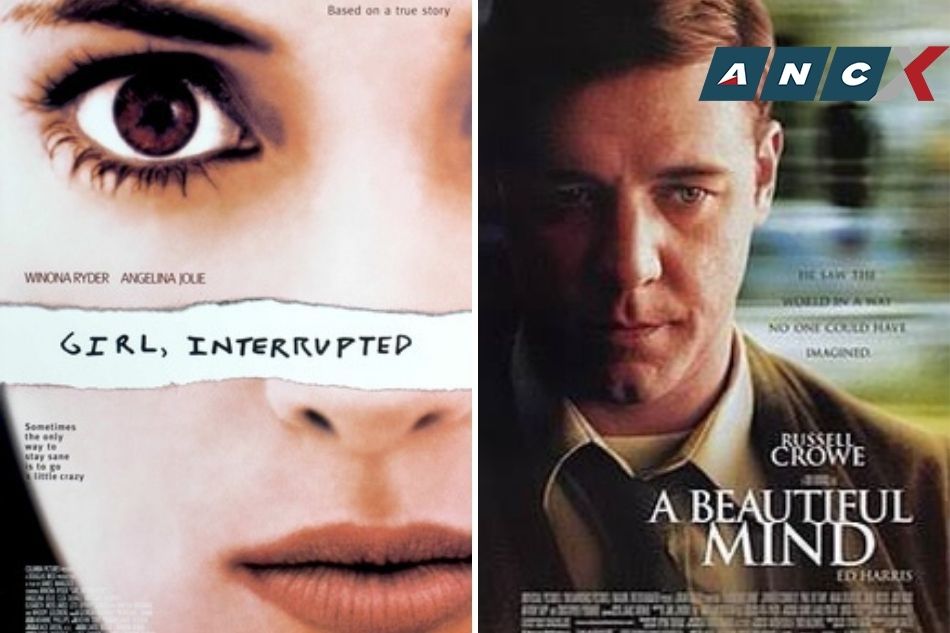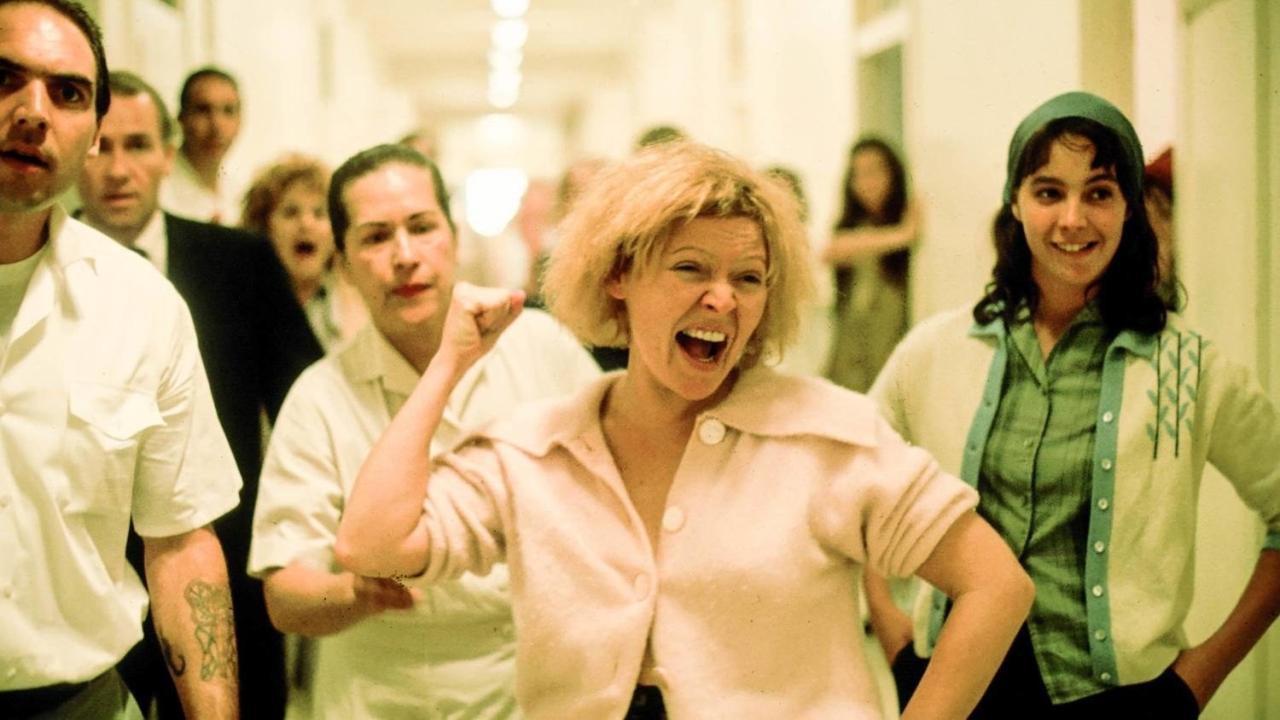U.S. 21+ Films About Mental Health and Trauma offers a compelling exploration of how American cinema depicts mental illness and trauma. This analysis delves into the nuances of film representation, examining how various genres and cinematic techniques shape our understanding of these complex issues. We’ll explore character development, societal influences, and ethical considerations, ultimately assessing the impact of these films on public perception.
The study will cover a wide range of films, analyzing how they portray different trauma types, including PTSD, complex grief, and childhood trauma, as well as the journeys of characters grappling with mental illness. We’ll also investigate the portrayal of treatment and recovery, the role of support systems, and the ethical implications of depicting mental health struggles on screen. The analysis will further consider the use of visual and auditory elements in storytelling and how genre conventions influence the representation of mental health.
Film Representation of Trauma Types

Film depictions of trauma offer a complex and often controversial window into the human experience. While aiming for accuracy, cinematic portrayals inevitably simplify the multifaceted nature of trauma, sometimes prioritizing narrative impact over clinical precision. This necessitates a critical approach to evaluating how different trauma types are represented on screen, understanding both the potential for education and the risk of misrepresentation.
PTSD in Film
Many films effectively portray the symptoms and struggles associated with Post-Traumatic Stress Disorder (PTSD). The jarring flashbacks, hypervigilance, and emotional numbness often depicted are recognizable to those familiar with the condition. For example, Sam Mendes’ *1917* masterfully uses immersive cinematography to convey the constant threat and lasting psychological impact of trench warfare on the protagonist, while *The Deer Hunter* (1978) powerfully depicts the long-term effects of the Vietnam War on its characters through vivid flashbacks and emotional breakdowns. These films show the debilitating nature of PTSD, highlighting its lasting impact on individuals’ lives.
Portrayals of Complex Grief
Complex grief, often extending beyond the typical grieving process, is sometimes subtly yet effectively explored in film. In *Manchester by the Sea* (2016), the protagonist’s muted emotional response to his brother’s death and the resulting self-destructive behavior illustrate the complexities of grief when compounded by guilt and past trauma. The film avoids sentimentalization, focusing instead on the protagonist’s quiet, internal struggle to process his loss. Similarly, the film *Moonlight* (2016) depicts the lingering emotional consequences of childhood trauma and its impact on the character’s ability to form healthy relationships and process grief effectively.
Depiction of Childhood Trauma
Films often tackle the devastating effects of childhood trauma, showing how early experiences shape adult personalities and relationships. *Precious* (2009) unflinchingly portrays the abuse and neglect suffered by its protagonist, highlighting the lasting psychological damage and the arduous journey towards healing. The film’s power lies in its honest depiction of the protagonist’s resilience and her slow, painstaking progress toward self-acceptance. Similarly, *Room* (2015) showcases the resilience of a mother and son who have endured years of captivity, focusing on the emotional and psychological adjustments they must make to reintegrate into society. These films demonstrate the enduring impact of early trauma and the importance of support systems in recovery.
Film Representations of Dissociative Disorders
Dissociative disorders, involving disruptions in consciousness, memory, and identity, present significant challenges for cinematic portrayal. While some films attempt to depict the fragmented sense of self characteristic of these disorders, it’s crucial to remember that cinematic depictions should not be used as diagnostic tools. The portrayal of dissociative identity disorder (DID) in films like *Split* (2016) and *Sybil* (1976) while engaging, often simplifies the complexity of the condition. While they may visually represent some of the outward manifestations, such as shifts in personality and behavior, the internal experience of DID is significantly more nuanced and less easily captured on screen. The films’ focus on dramatic effect can sometimes overshadow the complexities of the disorder.
Character Development and Mental Health Journeys
Exploring the portrayal of mental health journeys in film offers valuable insights into the complexities of these experiences. Analyzing character arcs allows for a deeper understanding of both the struggles and potential for recovery depicted on screen. This section will examine specific examples to illustrate the nuanced ways filmmakers approach these sensitive subjects.
The Arc of a Character’s Mental Health Journey in “Silver Linings Playbook”
Pat Solitano Jr., in “Silver Linings Playbook,” experiences a compelling arc of mental health recovery. Initially, he is grappling with bipolar disorder and the aftermath of a breakdown, manifested in erratic behavior, intense mood swings, and difficulty maintaining relationships. His journey is marked by both setbacks and progress. He initially relies on denial and anger, struggling to accept his diagnosis and treatment. However, through therapy, medication, and a burgeoning relationship with Tiffany, he gradually learns to manage his symptoms, confront his past trauma, and develop healthier coping mechanisms. His eventual participation in a dance competition symbolizes his triumph over his illness and his ability to embrace life’s uncertainties. This arc isn’t linear; it’s filled with relapses and moments of doubt, reflecting the realistic challenges of mental health recovery.
Comparative Analysis of Coping Mechanisms: Pat Solitano Jr. and Tiffany Maxwell
Pat and Tiffany, both dealing with mental health challenges in “Silver Linings Playbook,” employ contrasting coping strategies. Pat initially relies on self-medication, denial, and obsessive behaviors, stemming from his trauma and manic episodes. He attempts to regain control through rigid routines and intense focus on specific goals, like winning back his wife. Tiffany, on the other hand, uses deflection and self-destructive behaviors, masking her grief and trauma with a facade of bravado and reckless abandon. She uses sex and risk-taking as a way to numb her emotional pain. While neither approach is healthy, their contrasting methods highlight the diversity of coping mechanisms individuals utilize when confronted with mental illness. Both characters ultimately find some measure of healing through connection and mutual support, although their pathways differ significantly.
Key Turning Points in Pat Solitano Jr.’s Struggle
Several key turning points define Pat’s journey. His initial commitment to therapy marks a significant shift, albeit a reluctant one. His subsequent confrontation with his past trauma and the realization that his obsessive behaviors are counterproductive represent crucial steps toward self-awareness. The development of his relationship with Tiffany, while initially fueled by unhealthy dynamics, ultimately provides him with much-needed support and encouragement. Finally, his successful performance in the dance competition serves as a powerful symbol of his recovery and acceptance of his condition. These moments showcase the incremental nature of recovery and the importance of both professional help and personal connection.
Timeline of Pat Solitano Jr.’s Mental Health Progression
- Initial State (Beginning of the film): Experiencing intense mood swings, paranoia, and difficulty controlling his anger. He is recently released from a mental health facility and struggles to adjust to life outside.
- Therapy and Medication: Begins attending therapy sessions and takes medication, showing some initial improvement in managing his symptoms, but also experiencing resistance and setbacks.
- Relationship with Tiffany: Forms a complex and initially volatile relationship with Tiffany, which initially exacerbates his instability but ultimately provides support and a catalyst for growth.
- Confronting Past Trauma: Begins to confront his past trauma and the roots of his mental health struggles. This leads to emotional breakthroughs and a greater understanding of himself.
- Dance Competition: Successfully participates in the dance competition, symbolizing his progress, acceptance of his condition, and ability to embrace life’s challenges.
- Resolution (End of the film): Shows signs of sustained recovery, demonstrating improved emotional regulation, healthier relationships, and a more optimistic outlook.
Impact of Societal Factors on Mental Health Portrayals
The portrayal of mental illness and trauma in film is profoundly shaped by societal attitudes, cultural norms, and socioeconomic realities. These factors not only influence how these conditions are depicted but also impact the narratives presented and the messages conveyed to audiences. Understanding this complex interplay is crucial for analyzing the effectiveness and potential impact of films dealing with mental health.
Societal stigma significantly impacts how mental illness is portrayed on screen. For decades, films often depicted individuals with mental illness as violent, unpredictable, or inherently flawed. This reinforces negative stereotypes and perpetuates misunderstanding. Even when attempting to offer a sympathetic portrayal, films may unintentionally fall back on harmful tropes, such as the “mad genius” archetype, which romanticizes mental illness while simultaneously perpetuating damaging misconceptions. More recent films, however, are increasingly challenging these stereotypes by showcasing the nuanced realities of living with mental illness, emphasizing the importance of seeking help and recovery.
Societal Stigma and Film Representations of Mental Illness
The impact of societal stigma is evident in the historical trajectory of mental health portrayals in film. Early cinematic representations often relied on sensationalized depictions of individuals confined to asylums, reinforcing the idea of mental illness as something to be feared and isolated. This approach, while reflecting prevailing societal attitudes at the time, contributed to the stigmatization of mental illness. The shift towards more nuanced portrayals in contemporary cinema reflects a gradual societal shift towards greater understanding and acceptance. However, the lingering effects of past negative representations continue to influence how mental health is presented, even in films aiming for greater accuracy and sensitivity. The challenge remains in completely dismantling the harmful stereotypes that have been deeply ingrained in popular culture.
Cultural Backgrounds and Trauma Representation
Cultural backgrounds significantly shape the experience and expression of trauma. The ways in which trauma is understood, processed, and even discussed vary considerably across different cultures. For example, a film portraying the effects of war trauma on a veteran from a collectivist culture might emphasize the impact on family and community, whereas a film focusing on a veteran from an individualistic culture might prioritize the individual’s personal struggle. Similarly, cultural beliefs surrounding mental health and help-seeking behaviors will affect how characters respond to trauma and the support systems they access. Failure to acknowledge these cultural nuances can lead to inaccurate and potentially offensive representations of trauma and its consequences. Accurate portrayal necessitates thorough research and consultation with experts from relevant cultural backgrounds.
Socioeconomic Factors and Mental Health
Socioeconomic factors play a crucial role in shaping characters’ mental health journeys. Access to quality healthcare, resources, and supportive environments varies significantly based on socioeconomic status. Films depicting characters from disadvantaged backgrounds often highlight the added challenges they face in accessing mental health services, navigating systemic inequalities, and coping with stressors related to poverty, discrimination, and lack of opportunity. This representation can raise awareness about the social determinants of mental health and the need for equitable access to care. Conversely, films featuring characters with higher socioeconomic status might portray different struggles, such as the pressures of maintaining a certain image or dealing with the complexities of privilege. A balanced portrayal needs to acknowledge the diverse ways in which socioeconomic status intersects with mental health.
Mental Health Depictions Across Different Film Eras
Comparing mental health depictions across different film eras reveals a significant evolution in understanding and representation. Early films often presented simplistic and stigmatizing views of mental illness, reflecting the limited understanding and prevalent societal biases of the time. The mid-20th century saw a gradual shift, with some films beginning to explore the complexities of mental health, albeit often through melodramatic or sensationalized narratives. Contemporary cinema showcases a wider range of approaches, with many films aiming for greater accuracy, sensitivity, and nuanced portrayals. This progression reflects evolving societal attitudes towards mental health and the increasing awareness of the importance of accurate and responsible representation. However, the ongoing challenge remains in moving beyond stereotypical portrayals and creating authentic representations that resonate with diverse audiences.
Treatment and Recovery Portrayals in Film
Films offer a window into the complexities of mental health treatment and recovery, often portraying a range of therapeutic approaches and illustrating the diverse paths individuals take toward healing. While fictional, these portrayals can raise awareness, spark discussion, and even offer a sense of hope or understanding for viewers grappling with similar experiences. However, it’s crucial to remember that film representations are not substitutes for professional medical advice.
Therapeutic Approaches in Film
The depiction of therapeutic approaches in film varies widely, often reflecting the evolving understanding of mental health treatment over time. Some films accurately portray specific therapies, while others offer more generalized or even inaccurate representations. The following table compares different approaches as depicted in various films:
| Therapeutic Approach | Film Example | Portrayal Strengths | Portrayal Weaknesses |
|---|---|---|---|
| Cognitive Behavioral Therapy (CBT) | Silver Linings Playbook | Shows the structured nature of CBT, focusing on identifying and changing negative thought patterns and behaviors. | May oversimplify the complexity of CBT and the time commitment involved. |
| Psychoanalysis/Psychodynamic Therapy | The Aviator | Explores the unconscious mind and past experiences to understand present-day struggles. | Can be portrayed as slow-paced and less focused on immediate symptom relief. |
| Group Therapy | The Perks of Being a Wallflower | Highlights the benefits of shared experience and support from peers. | May not fully represent the challenges and dynamics inherent in group settings. |
| Medication Management | Touched with Fire | Shows the role of medication in managing symptoms, often in conjunction with therapy. | Can sometimes minimize the importance of therapeutic intervention. |
Successful and Unsuccessful Recovery Processes in Film
Films often depict both successful and unsuccessful recovery journeys, reflecting the reality that healing is not always linear. Silver Linings Playbook, for instance, shows a successful recovery process where the protagonist, through therapy and personal effort, manages his bipolar disorder and builds meaningful relationships. In contrast, a film like Black Swan illustrates a more tragic trajectory, where the protagonist’s mental health deteriorates despite therapy, ultimately leading to a devastating outcome. These contrasting narratives highlight the diverse experiences and outcomes associated with mental health recovery.
Portrayal of the Therapeutic Relationship
The therapeutic relationship is often a central element in films depicting mental health journeys. The portrayal of this relationship can significantly impact the film’s message and effectiveness. In some films, like Good Will Hunting, the therapist-patient dynamic is depicted as a strong, collaborative partnership built on trust and mutual respect. Other films may showcase a more challenging relationship, reflecting the complexities and potential power imbalances inherent in therapy. The level of empathy, understanding, and professional boundaries exhibited by the therapist on screen greatly influences the viewer’s perception of effective treatment.
Symbolism and Metaphor in Recovery Portrayals: A Beautiful Mind
A Beautiful Mind uses several powerful symbols and metaphors to represent John Nash’s journey of recovery from schizophrenia. The recurring image of the imaginary roommate represents the intrusive thoughts and hallucinations that characterize his illness. The gradual fading of these hallucinations, coupled with his increasing reliance on his wife’s support and his own self-awareness, acts as a visual metaphor for his recovery process. The film’s narrative arc, moving from profound delusion to a fragile but meaningful acceptance of his condition, visually embodies the long and challenging path toward recovery from severe mental illness.
The Role of Support Systems in Film Narratives
Film narratives frequently depict the crucial role of support systems in navigating mental health challenges and trauma. The presence or absence of supportive relationships significantly influences a character’s journey, impacting their resilience, recovery trajectory, and overall well-being. This section will examine the various types of support systems portrayed in film, their effectiveness, and their influence on the characters’ mental health journeys.
Effective support systems are portrayed as instrumental in facilitating healing and recovery, while their absence often exacerbates suffering and hinders progress. The quality of these relationships, rather than simply their existence, proves critical. A supportive network can provide validation, encouragement, practical assistance, and a sense of belonging, all essential for navigating the complexities of mental illness and trauma.
Types of Support Systems Depicted in Film
Films often showcase a range of support systems, reflecting the multifaceted nature of human relationships. These systems can be broadly categorized as familial, friendly, and professional. Family support can include parents, siblings, or other relatives offering emotional comfort, practical aid, or financial assistance. Friends provide companionship, understanding, and shared experiences, often acting as confidantes and sources of strength. Professional support encompasses therapists, psychiatrists, support groups, and other healthcare professionals providing specialized guidance and treatment. The effectiveness of each type of support varies greatly depending on the individual circumstances and the quality of the relationship.
Impact of the Absence of Support Systems on Mental Health
The absence of adequate support systems frequently exacerbates mental health challenges in film narratives. Characters lacking such systems often experience increased feelings of isolation, loneliness, and hopelessness. This isolation can impede their ability to cope with stress, access necessary resources, and adhere to treatment plans. The absence of emotional support can lead to a sense of being misunderstood or alone in their struggles, which can significantly worsen their symptoms. The film “Manchester by the Sea,” for example, powerfully illustrates the devastating effects of isolation and the lack of a supportive network on a character grappling with grief and trauma. The protagonist’s inability to connect with others contributes to his deep-seated depression and struggles with self-destruction.
Examples of Effective and Ineffective Support Systems in Film
Effective support systems in film are often characterized by empathy, understanding, and consistent support. For instance, the supportive friend in “Silver Linings Playbook” demonstrates patience and genuine care, helping the protagonist navigate his bipolar disorder. Conversely, ineffective support systems are often depicted as judgmental, dismissive, or enabling. A family that denies or minimizes a character’s mental health struggles, as seen in certain portrayals of addiction, can hinder their recovery and exacerbate their distress. The film “The Perks of Being a Wallflower” presents both effective and ineffective support systems; the protagonist finds solace in his supportive friends but struggles with the lack of understanding from his family.
Contribution of Support Systems to Recovery Processes, U.S. 21+ Films About Mental Health and Trauma
Supportive relationships play a pivotal role in facilitating recovery from mental health challenges and trauma. A strong support system provides a sense of belonging, reducing feelings of isolation and shame. This validation helps individuals feel more comfortable seeking help and adhering to treatment plans. Practical assistance, such as help with daily tasks or financial support, can significantly reduce stress and improve overall well-being. Emotional support, in the form of empathy and understanding, is crucial for fostering hope and resilience. The presence of a supportive network can significantly shorten the recovery process and improve long-term outcomes. Conversely, a lack of support can lead to relapse, increased suffering, and a prolonged recovery period.
Ethical Considerations in Depicting Mental Illness
Filmmakers hold a significant responsibility when portraying mental illness. The potential for both positive and negative impact on public perception is immense, demanding careful consideration of ethical implications. Accurate and sensitive depictions can foster understanding and reduce stigma, while inaccurate or exploitative portrayals can reinforce harmful stereotypes and contribute to discrimination.
The power of film lies in its ability to shape public understanding and influence attitudes towards complex issues like mental health. However, this power necessitates a commitment to responsible storytelling that prioritizes accuracy, empathy, and avoids perpetuating harmful stereotypes. A failure to uphold these ethical standards can have serious consequences for individuals struggling with mental illness and their families.
Misrepresentation and Stigmatization in Film Portrayals
Films often fall short in their representation of mental illness, frequently relying on harmful stereotypes. The “crazy” villain, the unpredictable and violent character, or the individual whose suffering is solely for dramatic effect are common tropes. These depictions perpetuate the stigmatization of mental illness, reinforcing negative perceptions and contributing to fear and misunderstanding. Such portrayals can hinder individuals from seeking help, fearing judgment or societal rejection. The lack of nuanced representation further isolates those experiencing mental health challenges, making them feel misunderstood and alone. For example, a character whose only defining trait is their schizophrenia, depicted solely through erratic behavior and violence, reinforces damaging stereotypes and fails to represent the complexity of the condition.
Examples of Accurate and Sensitive Depictions of Mental Health Struggles
While many films perpetuate harmful stereotypes, some offer nuanced and sensitive portrayals of mental health struggles. “Silver Linings Playbook” (2012), for instance, depicts bipolar disorder with a degree of realism, showcasing both the challenges and the resilience of individuals living with the condition. The film avoids simplistic portrayals and portrays the characters’ journeys with empathy and understanding. Similarly, “Manchester by the Sea” (2016) explores themes of grief and trauma with sensitivity, demonstrating the complex emotional landscape of dealing with loss and its impact on mental well-being. These films, through their careful character development and avoidance of sensationalism, offer a more compassionate and accurate representation of mental health struggles.
Films That Could Have Improved Their Portrayal of Mental Illness
Conversely, some films fall short in their ethical considerations. Certain thriller or horror films often use mental illness as a plot device, employing stereotypes to create fear or suspense without considering the real-life impact of such depictions. For example, a film that portrays multiple personality disorder solely as a tool for violent acts without acknowledging the complexity of the condition and the suffering of those who live with it, significantly contributes to the stigmatization and misunderstanding of the disorder. These films would benefit from consulting mental health professionals to ensure accuracy and sensitivity in their portrayals. The use of responsible storytelling would create a more ethical and impactful narrative.
The Importance of Responsible Storytelling When Addressing Mental Health Themes
Responsible storytelling is paramount when addressing mental health themes in film. This involves consulting with mental health professionals, portraying characters with depth and complexity, and avoiding the use of harmful stereotypes. The focus should be on promoting understanding and empathy, not sensationalism or fear-mongering. Filmmakers have a responsibility to create narratives that accurately reflect the experiences of individuals living with mental illness, challenging misconceptions and fostering a more compassionate and inclusive society. By prioritizing ethical considerations, films can play a vital role in reducing stigma and promoting help-seeking behaviors.
The Use of Visual and Auditory Elements in Storytelling: U.S. 21+ Films About Mental Health And Trauma
Filmmakers employ a range of visual and auditory techniques to effectively convey the complexities of mental health and trauma, moving beyond simple narrative to create a visceral and emotionally resonant experience for the viewer. These techniques work in concert to immerse the audience in the character’s internal world, allowing for a deeper understanding of their struggles and experiences.
Cinematography, sound design, color palettes, and editing all play crucial roles in shaping the audience’s perception and emotional response to the narrative. By carefully manipulating these elements, filmmakers can enhance the impact of the story and foster empathy for characters grappling with mental health challenges.
Cinematography and the Depiction of Internal States
Cinematography is a powerful tool for conveying a character’s internal state. For instance, shaky camera work can represent anxiety or disorientation, while slow, deliberate movements might suggest depression or a sense of detachment. Extreme close-ups can highlight a character’s emotional turmoil, focusing on facial expressions and subtle physical cues that betray their inner struggles. Conversely, wide shots can convey feelings of isolation or insignificance. The use of distorted lenses or unusual angles can visually represent a character’s altered perception of reality, as seen in films depicting dissociative disorders. In the film *Black Swan*, for example, the increasingly erratic camera movements mirror the protagonist’s deteriorating mental state.
Sound Design and Emotional Impact
Sound design plays a crucial role in amplifying the emotional impact of scenes depicting mental health struggles. Diegetic sounds (sounds that exist within the world of the film) can be used to reflect a character’s internal experience. For example, the heightened volume of everyday noises might represent auditory hallucinations or heightened sensitivity associated with anxiety disorders. Non-diegetic sounds (sounds added in post-production) such as unsettling music or jarring sound effects can create a sense of unease or dread, mirroring the character’s emotional turmoil. The absence of sound, or a sudden shift in soundscape, can also be incredibly effective in emphasizing moments of intense emotional distress or disconnection. The film *A Beautiful Mind* uses a subtle yet unsettling soundscape to represent the protagonist’s schizophrenia.
Color Palettes and Emotional States
Color palettes are often strategically used to reflect the emotional states of characters and the overall tone of the film. Desaturated or muted colors can be used to portray feelings of depression, hopelessness, or emotional numbness. Conversely, vibrant or contrasting colors might be used to represent moments of heightened emotion, mania, or even hallucinations. The use of specific colors can also be symbolic; for example, red might represent anger or danger, while blue might represent sadness or tranquility. The consistent use of a particular color scheme throughout a film can reinforce the overall emotional arc of the narrative. The film *Manchester by the Sea* utilizes a predominantly muted color palette to reflect the protagonist’s grief and despair.
Editing Techniques and the Portrayal of Trauma
Editing techniques significantly contribute to the portrayal of trauma in film. Rapid cuts can create a sense of disorientation and chaos, mirroring the fragmented memories or experiences often associated with trauma. Slow-motion sequences can emphasize specific moments of intense emotional pain or vulnerability. Juxtaposing seemingly unrelated scenes through cross-cutting can represent the disjointed nature of traumatic memories. The use of flashbacks or dream sequences can allow filmmakers to depict the intrusive and often unpredictable nature of traumatic memories. The editing in films like *The Hurt Locker* effectively uses rapid cuts and jarring transitions to portray the disorienting and overwhelming effects of combat trauma.
Genre Conventions and Mental Health Themes
The portrayal of mental health in film is significantly shaped by the genre conventions of the movie. Different genres employ distinct narrative structures, visual styles, and character archetypes, all of which influence how mental illness is depicted, impacting audience understanding and perception. This analysis will explore how genre conventions impact the representation of mental health, examining both effective and potentially problematic portrayals.
Genre significantly impacts the presentation of mental illness, influencing both the narrative structure and the visual language employed. For instance, a dramatic film might offer a nuanced exploration of a character’s internal struggles, while a thriller could use mental instability as a plot device, emphasizing suspense and mystery over emotional depth. Horror films, meanwhile, often utilize mental illness as a source of fear and otherness, potentially perpetuating harmful stereotypes.
In this topic, you find that Scariest 21+ Horror Films is very useful.
Dramatic Portrayals of Mental Illness
Drama films often provide more realistic and nuanced portrayals of mental health challenges. These films frequently prioritize character development and emotional depth, allowing audiences to empathize with characters grappling with mental illness. Examples include films like “Silver Linings Playbook,” which explores bipolar disorder with sensitivity, or “Manchester by the Sea,” which subtly depicts the effects of grief and trauma. These films often avoid sensationalizing mental illness, focusing instead on the human experience of suffering and resilience. The use of realistic dialogue and relatable characters creates a connection with the audience, promoting understanding and reducing stigma.
Thriller and Horror’s Use of Mental Instability
Thriller and horror genres frequently employ mental instability as a plot device. In thrillers, a character’s unstable mental state can create suspense and uncertainty, raising questions about their reliability and motivations. Horror films often utilize mental illness to create fear and disgust, sometimes portraying individuals with mental illness as monstrous or inherently dangerous. Examples include films that feature unreliable narrators whose mental state is a key element of the mystery or films where the protagonist’s mental breakdown is the source of the horror. While these genres can effectively create suspense, they risk perpetuating negative stereotypes and reducing complex mental health issues to simplistic tropes. The emphasis on shock value can overshadow the human element, hindering genuine understanding.
Genre Tropes Related to Mental Illness
Several genre tropes are frequently associated with mental illness in film. The “mad scientist” trope, common in science fiction and horror, depicts a brilliant but unstable individual whose experiments have dire consequences. The “split personality” trope, often found in thrillers and horror, presents a character with multiple distinct identities, each with its own motivations and behaviors. The “psychotic killer” trope, prevalent in horror, depicts individuals with mental illness as inherently violent and dangerous. These tropes, while effective in creating suspense or fear, can be deeply harmful, perpetuating stereotypes and reinforcing negative perceptions of mental illness. They often lack the nuance and complexity necessary for a responsible and accurate portrayal.
Effectiveness of Different Genres in Conveying Mental Health Themes
The effectiveness of different genres in conveying mental health themes varies considerably. Drama films, with their focus on character development and emotional depth, generally offer more nuanced and accurate representations. However, thriller and horror films, while potentially impactful in raising awareness, risk reinforcing harmful stereotypes if not handled carefully. Comedy, when used thoughtfully, can offer a lighter approach to sensitive topics, but needs to avoid trivializing or mocking the struggles of individuals with mental illness. The key lies in responsible storytelling that prioritizes empathy, accuracy, and avoids sensationalism. Ultimately, the genre itself is not the determining factor, but rather the creative choices made within that genre.
Impact of Film on Public Perception of Mental Health
Films wield considerable power in shaping public understanding and perceptions of mental illness. Their ability to humanize experiences, present diverse narratives, and reach vast audiences makes them a significant force in influencing societal attitudes towards mental health. By showcasing the complexities of mental illness through compelling characters and storylines, films can foster empathy, challenge stereotypes, and ultimately contribute to a more informed and compassionate public discourse.
Films can significantly impact the reduction of stigma surrounding mental health by normalizing conversations about mental illness and challenging negative stereotypes. Through authentic portrayals of individuals struggling with mental health challenges, films can humanize the experience, making it relatable and less frightening for viewers. This, in turn, can encourage individuals to seek help without fear of judgment or discrimination. Effective storytelling can move audiences emotionally, prompting reflection and a greater understanding of the struggles faced by those living with mental illness.
Films with Significant Impact on Public Discourse About Mental Health
Several films have profoundly impacted public conversations about mental health. For instance, *Silver Linings Playbook* (2012) offered a nuanced portrayal of bipolar disorder, sparking discussions about the complexities of the illness and the importance of support systems. The film’s popularity helped to bring the topic into mainstream conversation, fostering greater awareness and understanding. Similarly, *A Beautiful Mind* (2001), while facing criticism for some of its depictions, initiated important conversations around schizophrenia and its impact on individuals and their families. The film’s widespread viewership exposed a large audience to the realities of the illness, even if imperfectly. These examples illustrate how impactful films can be in shaping public perception and generating dialogue.
Films Promoting Positive Messaging Regarding Mental Health
It is crucial to highlight films that actively promote positive messaging regarding mental health and recovery. *Inside Out* (2015), an animated film, effectively utilized allegorical representation to explain complex emotions and their importance to mental wellbeing, making the topic accessible and engaging for a wide age range. The film’s success in normalizing the discussion of emotions, even among children, demonstrates the potential for positive impact through creative storytelling. Other films, such as *Manchester by the Sea* (2016), while depicting grief and trauma, also showcase the resilience of the human spirit and the importance of seeking support in navigating difficult emotional experiences. These films offer hope and emphasize the possibility of healing and recovery, countering the often-negative stereotypes associated with mental health struggles.
Exploring the Depiction of Violence and Trauma

Films depicting mental health often intersect with portrayals of violence, either as a cause, consequence, or both. Understanding how these elements are intertwined is crucial for analyzing the film’s message and its potential impact on viewers. The representation of violence in relation to mental illness needs careful consideration, balancing the need for authenticity with the potential for harmful stereotypes.
Films frequently depict various forms of violence related to mental health struggles. This can include self-harm, such as cutting or suicide attempts, often shown as a manifestation of intense emotional pain and a desperate attempt to cope with overwhelming feelings. Interpersonal violence, including domestic abuse or assault, can be portrayed as a direct consequence of mental illness, although this depiction should be approached carefully to avoid perpetuating harmful stereotypes. Finally, films might show violence perpetrated *against* individuals with mental illnesses, highlighting the societal stigma and prejudice they often face.
Types of Violence Portrayed in Relation to Mental Health
Several categories of violence appear frequently in films dealing with mental health. Physical violence can range from self-inflicted harm to acts of aggression against others. This often reflects the internal turmoil experienced by characters and the challenges they face in managing their emotions. Emotional violence, often subtler but equally damaging, might include verbal abuse, manipulation, or gaslighting, which can profoundly impact a character’s mental well-being. Structural violence, though less explicitly depicted, refers to systemic inequalities and societal injustices that contribute to mental health challenges. For example, a film might depict the lack of access to adequate healthcare or the discrimination faced by individuals with mental illness as forms of violence.
The Connection Between Trauma and the Development of Mental Illness in Film
Many films illustrate the strong link between experiencing trauma and the subsequent development of mental illness. Trauma, whether it’s a single event like a violent attack or prolonged abuse, can significantly impact a person’s psychological well-being. Films often show how unprocessed trauma can manifest as PTSD, depression, anxiety disorders, or other conditions. The depiction of the character’s journey in confronting their trauma and seeking help, or conversely, their struggle to cope without help, is a powerful tool for raising awareness. For instance, a character might exhibit flashbacks, nightmares, or avoidance behaviors as a result of past trauma, providing visual representations of the effects of such experiences.
Films Exploring the Long-Term Effects of Trauma
Several films effectively portray the long-term consequences of trauma on mental health. The Deer Hunter (1978) showcases the lasting impact of the Vietnam War on veterans, illustrating the pervasive nature of PTSD and its devastating effects on relationships and daily life. Manchester by the Sea (2016) powerfully depicts the lingering grief and emotional burden associated with a tragic loss, highlighting the complexities of coping with profound trauma over many years. Precious (2009) confronts the long-term effects of childhood abuse and neglect on a young woman, showing the resilience and strength required to overcome such adversity. These films demonstrate how trauma’s influence extends far beyond the initial event, impacting various aspects of a person’s life.
The Impactful and Potentially Harmful Depiction of Violence
The depiction of violence in films concerning mental health can be both profoundly impactful and potentially harmful. When handled responsibly, it can increase awareness and empathy, providing viewers with a deeper understanding of the challenges faced by individuals with mental illnesses. However, irresponsible or stereotypical portrayals can reinforce negative biases and stigmatize individuals, potentially leading to harmful consequences. For instance, depicting individuals with mental illness solely as violent individuals reinforces harmful stereotypes and contributes to societal prejudice. Conversely, a nuanced portrayal that highlights the complexities of mental health and the struggles of individuals can foster greater understanding and compassion.
Closing Summary
In conclusion, the portrayal of mental health and trauma in U.S. 21+ films presents a multifaceted landscape reflecting societal attitudes, evolving understanding of mental illness, and the power of cinema to shape public perception. While some films excel in their sensitive and accurate depictions, others fall short, highlighting the ongoing need for responsible and nuanced storytelling. Further exploration into the ethical considerations and the impact of these portrayals is crucial for fostering a more informed and compassionate understanding of mental health.
In this topic, you find that The Role of Censorship in American 21+ Films is very useful.
Enhance your insight with the methods and methods of Streaming Platforms for 21+ Movies in the U.S..





